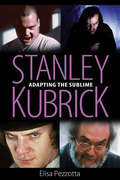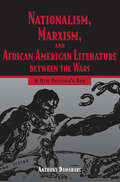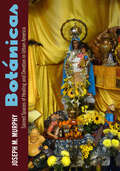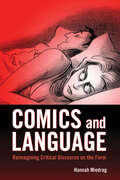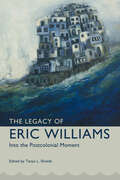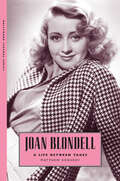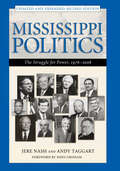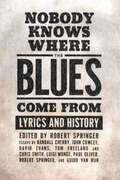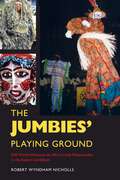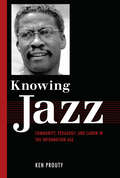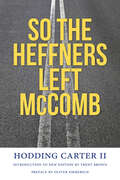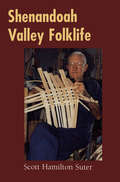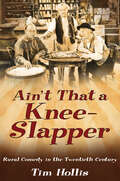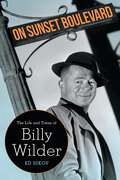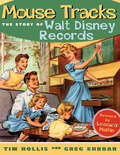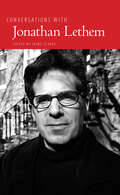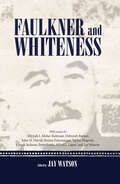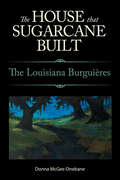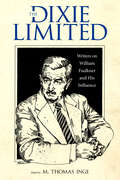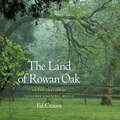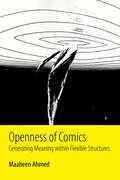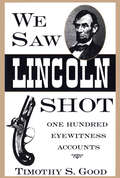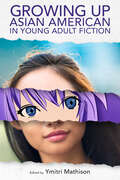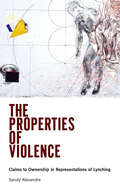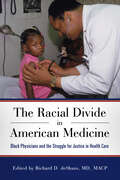- Table View
- List View
Stanley Kubrick: Adapting the Sublime
by Elisa PezzottaAlthough Stanley Kubrick adapted novels and short stories, his films deviate in notable ways from the source material. In particular, since 2001: A Space Odyssey (1968), his films seem to definitively exploit all cinematic techniques, embodying a compelling visual and aural experience. But, as author Elisa Pezzotta contends, it is for these reasons that his cinema becomes the supreme embodiment of the sublime, fruitful encounter between the two arts and, simultaneously, of their independence. Stanley Kubrick's last six adaptations—2001: A Space Odyssey, A Clockwork Orange (1971), Barry Lyndon (1975), The Shining (1980), Full Metal Jacket (1987), and Eyes Wide Shut (1999)—are characterized by certain structural and stylistic patterns. These features help to draw conclusions about the role of Kubrick in the history of cinema, about his role as an adapter, and, more generally, about the art of cinematic adaptations. The structural and stylistic patterns that characterize Kubrick adaptations seem to criticize scientific reasoning, causality, and traditional semantics. In the history of cinema, Kubrick can be considered a modernist auteur. In particular, he can be regarded as an heir of the modernist avant-garde of the 1920s. However, author Elisa Pezzotta concludes that, unlike his predecessors, Kubrick creates a cinema not only centered on the ontology of the medium, but on the staging of sublime, new experiences.
Nationalism, Marxism, and African American Literature between the Wars: A New Pandora's Box
by Anthony DawahareDuring and after the Harlem Renaissance, two intellectual forces—nationalism and Marxism—clashed and changed the future of African American writing. Current literary thinking says that writers with nationalist leanings wrote the most relevant fiction, poetry, and prose of the day. Nationalism, Marxism, and African American Literature Between the Wars: A New Pandora's Box challenges that notion. It boldly proposes that such writers as A. Philip Randolph, Langston Hughes, and Richard Wright, who often saw the world in terms of class struggle, did more to advance the anti-racist politics of African American letters than writers such as Countee Cullen, Jessie Redmon Fauset, Alain Locke, and Marcus Garvey, who remained enmeshed in nationalist and racialist discourse. Evaluating the great impact of Marxism and nationalism on black authors from the Harlem Renaissance and the Depression era, Anthony Dawahare argues that the spread of nationalist ideologies and movements between the world wars did guide legitimate political desires of black writers for a world without racism. But the nationalist channels of political and cultural resistance did not address the capitalist foundation of modern racial discrimination. During the period known as the “Red Decade” (1929–1941), black writers developed some of the sharpest critiques of the capitalist world and thus anticipated contemporary scholarship on the intellectual and political hazards of nationalism for the working class. As it examines the progression of the Great Depression, the book focuses on the shift of black writers to the Communist Left, including analyses of the Communists' position on the “Negro Question,” the radical poetry of Langston Hughes, and the writings of Richard Wright.
Botánicas: Sacred Spaces of Healing and Devotion in Urban America
by Joseph M. MurphyBotánicas is an exploration in text and photographs of spiritual shops found in Latino neighborhoods throughout the United States. Readers discover these marvelous spaces and their alternative spiritualties that help patrons cope with the grind and challenges of city life. Botánicas provide access to an array of invisible powers and sell the ingredients to construct symbolic solutions to their patrons' problems. The stores are bright and baroque, and the powers they invoke come from religious traditions in Africa, Europe, Asia, and the native Americas. In Botánicas, Joseph M. Murphy offers a cultural history of the devotions on display and a reflection on the efficacy of their powers to heal. Readers will come to see that the goods and devotions of botánicas give their patrons--mostly Latino, often immigrants--pathways for empowerment and transformation.The name botánicas comes from the "botanicals" for sale, herbs and plants with healing powers. The pharmacopeia of botánicas can be vast, and owners may know hundreds of remedies for treating problems of health, wealth, and love. Botánicas vend herbs for upset stomach, herbs for finding a job, and herbs for wooing back a wayward spouse. Supplementing these medicinal and magical plants, botánicas sell candles, holy statues, and tools for devotion to an array of spiritual powers--Catholic saints, African gods, indigenous spirits, and Asian divinities. Each spirit has its own ritual of petition, and botánica owners can discern the proper offerings and prayers to help the supplicant.Murphy explains the religions of the botánica with subtlety and sensitivity. He gives readers a deep sense of the contexts of the stores and a sophisticated analysis of the religious traditions that suffuse them. Visually fascinating, culturally rich, and religiously profound, Botánicas is a window into a world of beauty and power.
Comics and Language: Reimagining Critical Discourse on the Form
by Hannah MiodragIt has become an axiom in comic studies that "comics is a language, not a genre." But what exactly does that mean, and how is discourse on the form both aided and hindered by thinking of it in linguistic terms? In Comics and Language, Hannah Miodrag challenges many of the key assumptions about the "grammar" and formal characteristics of comics, and offers a more nuanced, theoretical framework that she argues will better serve the field by offering a consistent means for communicating critical theory in the scholarship. Through engaging close readings and an accessible use of theory, this book exposes the problems embedded in the ways critics have used ideas of language, literature, structuralism, and semiotics, and sets out a new and more theoretically sound way of understanding how comics communicate. Comics and Language argues against the critical tendency to flatten the distinctions between language and images and to discuss literature purely in terms of story content. It closely examines the original critical theories that such arguments purport to draw on and shows how they in fact point away from the conclusions they are commonly used to prove. The book improves the use the field makes of existing scholarly disciplines and furthers the ongoing sophistication of the field. It provides animated and insightful analyses of a range of different texts and takes an interdisciplinary approach. Comics and Language will appeal to the general comics reader and will prove crucial for specialized scholars in the fields of comics, literature, cultural studies, art history, and visual studies. It also provides a valuable summary of the current state of formalist criticism within comics studies and so presents the ideal text for those interested in exploring this growing area of research
The Legacy of Eric Williams: Into the Postcolonial Moment (Caribbean Studies Series)
by Tanya L. ShieldsThe Legacy of Eric Williams provides an indispensable and significant understanding of Eric Williams's contributions to the now independent nation of Trinidad and Tobago and his impact on the broader international understanding of the Caribbean. This book stands out because of its simultaneous investigation into Eric Williams as a scholar/intellectual, a political leader, and, most importantly, a key postcolonial figure. Most previous studies have treated these as separate arenas.The essays here confront the relevance of postcolonialism in understanding Williams's role both in post-independence Trinidad and Tobago and in newer understandings of Caribbean globalization. The volume divides into three broad sections--"Becoming Eric Williams," "Political Williams," and "Textual Williams." "Becoming Eric Williams" provides background on Williams and the Caribbean's ontological quest, addressing what it means to be West Indian and Caribbean. "Political Williams" engages with his policies and their consequences, describing the impact of Williams's political policies on several areas: integration, color stratification, and labor and public sector reform. Williams's far-reaching political influence in these aspects cements his legacy as one of the main public intellectuals responsible for creating the modern Caribbean. "Textual Williams" examines his scholarly contributions from a more traditional academic perspective. These sections allow for a comprehensive understanding of Williams as a man, a scholar, and a politician.
Joan Blondell: A Life between Takes (Hollywood Legends Series)
by Matthew KennedyJoan Blondell: A Life between Takes is the first major biography of the effervescent, scene-stealing actress (1906-1979) who conquered motion pictures, vaudeville, Broadway, summer stock, television, and radio. Born the child of vaudevillians, she was on stage by age three. With her casual sex appeal, distinctive cello voice, megawatt smile, luminous saucer eyes, and flawless timing, she came into widespread fame in Warner Bros. musicals and comedies of the 1930s, including Blonde Crazy, Gold Diggers of 1933, and Footlight Parade. Frequent co-star to James Cagney, Clark Gable, Edward G. Robinson, and Humphrey Bogart, friend to Judy Garland, Barbara Stanwyck, and Bette Davis, and wife of Dick Powell and Mike Todd, Joan Blondell was a true Hollywood insider. By the time of her death, she had made nearly 100 films in a career that spanned over fifty years. Privately, she was unerringly loving and generous, while her life was touched by financial, medical, and emotional upheavals. Joan Blondell: A Life between Takes is meticulously researched, expertly weaving the public and private, and features numerous interviews with family, friends, and colleagues.
Mississippi Politics: The Struggle for Power, 1976-2008, Second Edition
by Jere Nash Andy TaggartOriginally published in 2006, Mississippi Politics quickly became the definitive work on the state's recent political history, campaigns, legislative battles, and litigation, as well as how Mississippi shaped and was shaped by national and regional trends. A central theme of the 2006 edition was the state's gradual transition from a Democratic surety to a Republican stronghold. For this updated edition, authors Jere Nash and Andy Taggart examine the aftermath of the 2007 gubernatorial and 2008 presidential elections—and all the fireworks in between. This new edition adds a chapter covering the last two years and includes analyses of the 2007 and 2008 statewide, legislative, and federal elections; the resignations of Senator Trent Lott and Congressman Chip Pickering; the indictments of Richard Scruggs and other prominent lawyers; President Barack Obama's influence on the state's 2008 voting dynamics; and the election of House Speaker Billy McCoy.
Nobody Knows Where the Blues Come From: Lyrics and History (American Made Music Series)
by Robert SpringerMusicians and music scholars rightly focus on the sounds of the blues and the colorful life stories of blues performers. Equally important and, until now, inadequately studied are the lyrics. The international contributors to Nobody Knows Where the Blues Come From explore this aspect of the blues and establish the significance of African American popular song as a neglected form of oral history.“High Water Everywhere: Blues and Gospel Commentary on the 1927 Mississippi River Flood,” by David Evans, is the definitive study of songs about one of the greatest natural disasters in the history of the United States. In “Death by Fire: African American Popular Music on the Natchez Rhythm Club Fire,” Luigi Monge analyzes a continuum of songs about exclusively African American tragedy. “Lookin’ for the Bully: An Enquiry into a Song and Its Story,” by Paul Oliver traces the origins and the many avatars of the Bully song. In “That Dry Creek Eaton Clan: A North Mississippi Murder Ballad of the 1930s,” Tom Freeland and Chris Smith study a ballad recorded in 1939 by a black convict at Parchman prison farm. “Coolidge’s Blues: African American Blues from the Roaring Twenties” is Guido van Rijn’s survey of blues of that decade. Robert Springer's “On the Electronic Trail of Blues Formulas” presents a number of conclusions about the spread of patterns in blues narratives. In “West Indies Blues: An Historical Overview 1920s-1950s,” John Cowley turns his attention to West Indian songs produced on the American mainland. Finally, in “Ethel Waters: ‘Long, Lean, Lanky Mama,’” Randall Cherry reappraises the early career of this blues and vaudeville singer
The Jumbies' Playing Ground: Old World Influences on Afro-Creole Masquerades in the Eastern Caribbean (Folklore Studies in a Multicultural World Series)
by Robert Wyndham NichollsDuring the masquerades common during carnival time, jumbies (ghosts or ancestral spirits) are set free to roam the streets of Caribbean nations, turning the world topsy-turvy. Modern carnivals, which evolved from earlier ritual celebrations featuring disguised performers, are important cultural andeconomic events throughout the Caribbean, a direct link to a multilayered history.This work explores the evolutionary connections in function, garb, and behavior between Afro-Creole masquerades and precursors from West Africa, the British Isles, and Western Europe. Robert Wyndham Nicholls utilizes a concept of play derived from Africa to describe a range of lighthearted and ritualistic activities. Along with Old World seeds, he studies the evolution of Afro- Creole prototypes that emerged in the Eastern Caribbean--bush masquerades, stilt dancers, animal disguises, she-males, female masquerades, and carnival clowns. Masquerades enact social, political, and spiritual roles within recurring festivals, initiations, wakes, skimmingtons, and weddings. The author explores performance in terms of abstraction in costume-disguise and the aesthetics of music, songs, drum rhythms, dance, and licentiousness. He reveals masquerades as transformative agent, ancestral endorser, behavior manager, informal educator, and luck conferrer.
Knowing Jazz: Community, Pedagogy, and Canon in the Information Age (American Made Music Series)
by Ken ProutyKen Prouty argues that knowledge of jazz, or more to the point, claims to knowledge of jazz, are the prime movers in forming jazz's identity, its canon, and its community. Every jazz artist, critic, or fan understands jazz differently, based on each individual's unique experiences and insights. Through playing, listening, reading, and talking about jazz, both as a form of musical expression and as a marker of identity, each aficionado develops a personalized relationship to the larger jazz world. Through the increasingly important role of media, listeners also engage in the formation of different communities that not only transcend traditional boundaries of geography, but increasingly exist only in the virtual world. The relationships of "jazz people" within and between these communities is at the center of Knowing Jazz. Some groups, such as those in academia, reflect a clash of sensibilities between historical traditions. Others, particularly online communities, represent new and exciting avenues for everyday fans, whose involvement in jazz has often been ignored. Other communities seek to define themselves as expressions of national or global sensibility, pointing to the ever-changing nature of jazz's identity as an American art form in an international setting. What all these communities share, however, is an intimate, visceral link to the music and the artists who make it, brought to life through the medium of recording. Informed by an interdisciplinary approach and approaching the topic from a number of perspectives, Knowing Jazz charts a philosophical course in which many disparate perspectives and varied opinions on jazz can find common ground.
So the Heffners Left McComb (Civil Rights in Mississippi Series)
by Hodding Carter IIOn Saturday, September 5, 1964, the family of Albert W. "Red" Heffner Jr., a successful insurance agent, left their house at 202 Shannon Drive in McComb, Mississippi, where they had lived for ten years. They never returned. In the eyes of neighbors, their unforgiveable sin was to have spoken on several occasions with civil rights workers and to have invited two into their home. Consequently, the Heffners were subjected to a campaign of harassment, ostracism, and economic retaliation shocking to a white family who believed that they were respected community members. So the Heffners Left McComb, originally published in 1965 and reprinted now for the first time, is Greenville journalist Hodding Carter's account of the events that led to the Heffners' downfall. Historian Trent Brown, a McComb native, supplies a substantial introduction evaluating the book's significance. The Heffners' story demonstrates the forces of fear, conformity, communal pressure, and threats of retaliation that silenced so many white Mississippians during the 1950s and 1960s. Carter's book provides a valuable portrait of a family who was not choosing to make a stand, but merely extending humane hospitality. Yet the Heffners were systematically punished and driven into exile for what was perceived as treason against white apartheid.
Shenandoah Valley Folklife (Folklife in the South Series)
by Scott Hamilton SuterBordered by the Blue Ridge and the Allegheny Mountains, the Shenandoah Valley forms a natural corridor to the western parts of Virginia, Tennessee, and North Carolina. Early American settlers followed the valley as one of the first routes westward.In Shenandoah Valley Folklife, Scott Hamilton Suter documents the many peoples who have left their marks on the folkways of the region--Native Americans, Germans, Swiss, Scots-Irish, and African Americans. His research reveals how the first settlers there built homes, how they worshiped, and how they passed on legends and musical traditions that continue to play a role in the community today.Throughout the book, Suter argues that the valley's past plays a definitive role in its present. He finds family traditions still thriving in crafts like white oak basket-making, as well as in cooking and architecture. To illuminate the change and continuity in religious life, he focuses on Old Order Mennonites, the Church of the Brethren, and Baptists in the region. Using both historical sources and his own field work, Suter shows how folklife remains a powerful, resonant force in the Shenandoah, and how new immigrants are adapting and adding their own traditions to long-standing customs.
Ain't That a Knee-Slapper: Rural Comedy in the Twentieth Century
by Tim HollisThere was a time when rural comedians drew most of their humor from tales of farmers' daughters, hogs, hens, and hill country high jinks. Lum and Abner and Ma and Pa Kettle might not have toured happily under the "Redneck" marquee, but they were its precursors.In Ain't That a Knee-Slapper: Rural Comedy in the Twentieth Century, author Tim Hollis traces the evolution of this classic American form of humor in the mass media, beginning with the golden age of radio, when such comedians as Bob Burns, Judy Canova, and Lum and Abner kept listeners laughing. The book then moves into the motion pictures of the 1930s, 1940s, and 1950s, when the established radio stars enjoyed second careers on the silver screen and were joined by live-action renditions of the comic strip characters Li'l Abner and Snuffy Smith, along with the much-loved Ma and Pa Kettle series of films. Hollis explores such rural sitcoms as The Real McCoys in the late 1950s and from the 1960s, The Andy Griffith Show, The Beverly Hillbillies, Green Acres, Hee Haw, and many others. Along the way, readers are taken on side trips into the world of animated cartoons and television commercials that succeeded through a distinctly rural sense of fun.While rural comedy fell out of vogue and networks sacked shows in the early 1970s, the emergence of such hits as The Dukes of Hazzard brought the genre whooping back to the mainstream. Hollis concludes with a brief look at the current state of rural humor, which manifests itself in a more suburban, redneck brand of standup comedy.
On Sunset Boulevard: The Life and Times of Billy Wilder
by Ed SikovOn Sunset Boulevard, originally published in 1998, describes the life of acclaimed filmmaker Billy Wilder (1906-2002), director of such classics as Sunset Boulevard, The Lost Weekend, The Seven Year Itch, and Sabrina. This definitive biography takes the reader on a fast-paced journey from Billy Wilder's birth outside of Krakow in 1906 to Vienna, where he grew up, to Berlin, where he moved as a young man while establishing himself as a journalist and screenwriter, and triumphantly to Hollywood, where he became as successful a director as there ever was.Double Indemnity, Sunset Boulevard, Some Like It Hot, and The Apartment"Wilder's cinematic legacy is unparalleled. Not only did he direct these classics and twenty-one other films, he co-wrote all of his own screenplays. Volatile, cynical, hilarious, and driven, Wilder arrived in Hollywood an all-but-penniless refugee who spoke no English. Ten years later he was calling his own shots, and he stayed on top of the game for the next three decades. Wilder battled with Humphrey Bogart, Marilyn Monroe, Bing Crosby, and Peter Sellers; kept close friendships with William Holden, Audrey Hepburn, Jack Lemmon, and Walter Matthau; amassed a personal fortune by way of blockbuster films and shrewd investments in art (including Picassos, Klees, and Mir's); and won Oscars--yet Wilder, ever conscious of his thick accent, always felt the sting of being an outsider.On Sunset Boulevard traces the course of a turbulent but fabulous life, both behind the scenes and on the scene, from Viennese cafes and Berlin dance halls in the twenties to the Hollywood soundstages of the forties and the on-location shoots of the fifties and sixties. Crammed with Wilder's own caustic wit, On Sunset Boulevard reels out the story of one of cinema's most brilliant and prolific talents.
Mouse Tracks: The Story of Walt Disney Records
by Tim Hollis Greg EhrbarAround the world there are grandparents, parents, and children who can still sing ditties by Tigger or Baloo the Bear or the Seven Dwarves. This staying power and global reach is in large part a testimony to the pizzazz of performers, songwriters, and other creative artists who worked with Walt Disney Records. Mouse Tracks: The Story of Walt Disney Records chronicles for the first time the fifty-year history of the Disney recording companies launched by Walt Disney and Roy Disney in the mid-1950s, when Disneyland Park, Davy Crockett, and the Mickey Mouse Club were taking the world by storm. The book provides a perspective on all-time Disney favorites and features anecdotes, reminiscences, and biographies of the artists who brought Disney magic to audio. Authors Tim Hollis and Greg Ehrbar go behind the scenes at the Walt Disney Studios and discover that in the early days Walt Disney and Roy Disney resisted going into the record business before the success of "The Ballad of Davy Crockett" ignited the in-house label. Along the way, the book traces the recording adventures of such Disney favorites as Mickey Mouse, Donald Duck, Cinderella, Bambi, Jiminy Cricket, Winnie the Pooh, and even Walt Disney himself. Mouse Tracks reveals the struggles, major successes, and occasional misfires. Included are impressions and details of teen-pop princesses Annette Funicello and Hayley Mills, the Mary Poppins phenomenon, a Disney-style "British Invasion," and a low period when sagging sales forced Walt Disney to suggest closing the division down. Complementing each chapter are brief performer biographies, reproductions of album covers and art, and facsimiles of related promotional material. Mouse Tracks is a collector's bonanza of information on this little-analyzed side of the Disney empire. Learn more about the book and the authors at www.mousetracksonline.com.
Conversations with Jonathan Lethem (Literary Conversations Series)
by Jaime ClarkeConversations with Jonathan Lethem collects fourteen interviews, conducted over a decade and a half, with the Brooklyn-born author of such novels as Girl in Landscape, Motherless Brooklyn, The Fortress of Solitude, Chronic City, and many others. Winner of the National Book Critics' Circle Award, Lethem (b. 1964) covers a wide range of subjects, from what it means to incorporate genre into literature, to the impact of the death of his mother on his life and work, to his being a permanent "sophomore on leave" from Bennington College, as well as his flight from Brooklyn to California and its lasting effect on his fiction. Lethem also reveals the many literary and pop culture influences that have informed his writing life. Readers will find Lethem as charming and generous and intelligent as his work. His examination of what it means to live a creative life will reverberate and enlighten scholars and fans alike. His thoughts on science fiction, intellectual property, literary realism, genre, movies, and rock 'n' roll are articulated with elán throughout the collection, as are his comments on his own development as a craftsman.
Faulkner and Whiteness
by Jay WatsonWilliam Faulkner wrote during a tumultuous period in southern racial consciousness, between the years of the enactment of Jim Crow and the beginnings of the civil rights movement in the South. Throughout the writer's career, racial paradigms were in flux, and these shifting notions are reflected in Faulkner's prose. Faulkner's fiction contains frequent questions about the ways in which white Americans view themselves with regard to race along with challenges to the racial codes and standards of the region, and complex portrayals of the interactions between blacks and whites. Throughout his work, Faulkner contests white identity—its performance by whites and those passing for white, its role in shaping the South, and its assumption of normative identity in opposition to non-white “Others.” This is true even in novels without a strong visible African American presence, such as As I Lay Dying, The Hamlet, The Town, and The Mansion. Faulkner and Whiteness explores the ways in which Faulkner's fiction addresses and destabilizes the concept of whiteness in American culture. Collectively, the essays argue that whiteness, as part of the Nobel Laureate's consistent querying of racial dynamics, is a central element. This anthology places Faulkner's oeuvre—and scholarly views of it—in the contexts of its contemporary literature and academic trends exploring race and texts.
The House That Sugarcane Built: The Louisiana Burguières
by Donna McGee OnebaneThe House That Sugarcane Built tells the saga of Jules M. Burguières Sr. and five generations of Louisianans who, after the Civil War, established a sugar empire that has survived into the present. When twenty-seven-year-old Parisian immigrant Eugène D. Burguières landed at the Port of New Orleans in 1831, one of the oldest Louisiana dynasties began. Seen through the lens of one family, this book traces the Burguières from seventeenth-century France, to nineteenth- century New Orleans and rural south Louisiana and into the twenty-first century. It is also a rich portrait of an American region that has retained its vibrant French culture. As the sweeping narrative of the clan unfolds, so does the story of their family-owned sugar business, the J. M. Burguières Company, as it plays a pivotal role in the expansion of the sugar industry in Louisiana, Florida, and Cuba. The French Burguières were visionaries who knew the value of land and its bountiful resources. The fertile soil along the bayous and wetlands of south Louisiana bestowed on them an abundance of sugarcane above its surface, and salt, oil, and gas beneath. Ever in pursuit of land, the Burguières expanded their holdings to include the vast swamps of the Florida Everglades; then, in 2004, they turned their sights to cattle ranches on the great frontier of west Texas. Finally, integral to the story are the complex dynamics and tensions inherent in this family-owned company, revealing both failures and victories in its history of more than 135 years. The J. M. Burguières Company's survival has depended upon each generation safeguarding and nourishing a legacy for the next.
The Dixie Limited: Writers on William Faulkner and His Influence
by M. Thomas IngeFlannery O'Connor once noted, “The presence alone of Faulkner in our midst makes a great difference in what the writer can and cannot permit himself to do. Nobody wants his mule and wagon stalled on the same track the Dixie Limited is roaring down.” Her railroading metaphor wittily captures much of the respect and unease Faulkner's example brought the worldwide community of authors. Few other writers have exerted as profound an influence on literature as Faulkner. Prominent literary scholar M. Thomas Inge documents the scope of his influence in the twentieth century through the words of those writers themselves. This collection of essays offers a survey attempting to capture exactly what Faulkner meant to his literary peers and colleagues both in the United States and abroad. Inge has combed essays, articles, reviews, letters, and comments written by over forty novelists, poets, and playwrights about Faulkner's fiction and the power of his literary accomplishment. Many major American writers sound off here, as well as important figures from France, England, Japan, and South America. Some speak about his technical virtuosity and how this expertise has directly influenced them, and others express the difficulties of trying to escape his example. A few even criticize him for what they see as artistic failures. The variety of responses demonstrate, in any case, that Faulkner created an unavoidable power in his own time and remains a permanent force in literature.
The Land of Rowan Oak: An Exploration of Faulkner's Natural World
by Ed CroomThe plants and landscape at Rowan Oak are the “little postage stamp of soil” that William Faulkner owned, walked, and tended for over thirty years during the writing of many of his short stories and novels. Faulkner saw and smelled the earth and listened to sounds from the cultivated grounds and the surrounding woods. This is the place that offered him refuge for writing and provided him food from its garden, fruit and nut trees, and pasture for his horses and a milk cow. Rowan Oak boasts a diverse landscape, encompassing an aristocratic eastern redcedar-lined drive and walk as well as hardy ornamental shrubs, trees, pastures, and a hardwood forest with virgin timber. More than fifty years after Faulkner's death, Rowan Oak remains a sanctuary and a place of mystery and beauty nestled in the midst of Oxford, Mississippi. The photographs in The Land of Rowan Oak are botanist Ed Croom's exploration and documentation of the changes in the plants and landscape over more than a decade. Croom encountered early morning mists, the summer heat and haze, and even rare snowfalls in his near-daily walks on the grounds. His photographs record a decaying fence line, trees and plants that have since disappeared, and the newly restored sunken garden. This book honors the land Faulkner loved. While Faulkner's novels have left an indelible legacy in southern and American letters, the landscape of his beloved home also serves as a record of the botanical history of this most storied corner of the American literary South.
Openness of Comics: Generating Meaning within Flexible Structures
by Maaheen AhmedNever before have comics seemed so popular or diversified, proliferating across a broad spectrum of genres, experimenting with a variety of techniques, and gaining recognition as a legitimate, rich form of art. Maaheen Ahmed examines this trend by taking up philosopher Umberto Eco's notion of the open work of art, whereby the reader—or listener or viewer, as the case may be—is offered several possibilities of interpretation in a cohesive narrative and aesthetic structure. Ahmed delineates the visual, literary, and other medium-specific features used by comics to form open rather than closed works, methods by which comics generate or limit meaning as well as increase and structure the scope of reading into a work. Ahmed analyzes a diverse group of British, American, and European (Franco-Belgian, German, Finnish) comics. She treats examples from the key genre categories of fictionalized memoirs and biographies, adventure and superhero, noir, black comedy and crime, science fiction and fantasy. Her analyses demonstrate the ways in which comics generate openness by concentrating on the gaps essential to the very medium of comics, the range of meaning ensconced within words and images as well as their interaction with each other. The analyzed comics, extending from famous to lesser known works, include Will Eisner's The Contract with God Trilogy, Jacques Tardi's It Was the War of the Trenches, Hugo Pratt's The Ballad of the Salty Sea, Edmond Baudoin's The Voyage, Grant Morrison and Dave McKean's Arkham Asylum, Neil Gaiman's Sandman series, Alan Moore and Eddie Campbell's From Hell, Moebius's Arzach, Yslaire's Cloud 99 series, and Jarmo Mäkilä's Taxi Ride to Van Gogh's Ear.
We Saw Lincoln Shot: One Hundred Eyewitness Accounts
by Timothy S. GoodOn the evening of April 14,1865, when President Abraham Lincoln was assassinated in Ford's Theatre, an entire audience was witness to the tragedy. From diaries, letters, depositions, affidavits, and periodicals, here is a collection of accounts from a variety of theatergoers—who by chance saw one of the truly pivotal events in US history. Providing minute firsthand details recorded over a span of ninety years, We Saw Lincoln Shot explores a subject that will forever be debated. With a sharp focus upon the circumstances reported by one hundred actual witnesses, We Saw Lincoln Shot provides vivid documentation of a momentous evening and exposes errors that have been perpetuated as the assassination has been rendered into written histories.
Growing Up Asian American in Young Adult Fiction (Children's Literature Association Series)
by Ymitri MathisonWinner of the Children’s Literature Association’s 2020 Edited Book AwardContributions by Hena Ahmad, Linda Pierce Allen, Mary J. Henderson Couzelis, Sarah Park Dahlen, Lan Dong, Tomo Hattori, Jennifer Ho, Ymitri Mathison, Leah Milne, Joy Takako Taylor, and Traise Yamamoto Often referred to as the model minority, Asian American children and adolescents feel pressured to perform academically and be disinterested in sports, with the exception of martial arts. Boys are often stereotyped as physically unattractive nerds and girls as petite and beautiful. Many Americans remain unaware of the diversity of ethnicities and races the term Asian American comprises, with Asian American adolescents proving to be more invisible than adults. As a result, Asian American adolescents are continually searching for their identity and own place in American society. For these kids, being or considered to be American becomes a challenge in itself as they assert their Asian and American identities; claim their own ethnic identity, be they immigrant or American-born; and negotiate their ethnic communities. The contributors to Growing Up Asian American in Young Adult Fiction focus on moving beyond stereotypes to examine how Asian American children and adolescents define their unique identities. Chapters focus on primary texts from many ethnicities, such as Chinese, Korean, Filipino, Japanese, Vietnamese, South Asian, and Hawaiian. Individual chapters, crossing cultural, linguistic, and racial boundaries, negotiate the complex terrain of Asian American children’s and teenagers’ identities. Chapters cover such topics as internalized racism and self-loathing; hypersexualization of Asian American females in graphic novels; interracial friendships; transnational adoptions and birth searches; food as a means of assimilation and resistance; commodity racism and the tourist gaze; the hostile and alienating environment generated by the War on Terror; and many other topics.
The Properties of Violence: Claims to Ownership in Representations of Lynching
by Sandy AlexandreThe Properties of Violence focuses on two connected issues: representations of lynching in late-nineteenth and twentieth-century American photographs, poetry, and fiction; and the effects of those representations. Alexandre compellingly shows how putting representations of lynching in dialogue with the history of lynching uncovers the profound investment of African American literature—as an enterprise that continually seeks to create conceptual spaces for the disenfranchised culture it represents—in matters of property and territory. Through studies ranging from lynching photographs to Toni Morrison's Pulitzer Prize-winning novel, Beloved, the book demonstrates how representations of lynching demand that we engage and discuss various forms of possession and dispossession. The multiple meanings of the word “representation” are familiar to literary critics, but Alexandre's book insists that its other key term, “effects,” also needs to be understood in both of its primary senses. On the one hand, it indicates the social and cultural repercussions of how lynching was portrayed, namely, what effects its representations had. On the other hand, the word signals, too, the possessions or what we might call the personal effects conjured up by these representations. These possessions were not only material—as for example property in land or the things one owned. The effects of representation also included diverse, less tangible but no less real possessions shared by individuals and groups: the aura of a lynching site, the ideological construction of white womanhood, or the seemingly default capacity of lynching iconography to encapsulate the history of ostensibly all forms of violence against black people.
The Racial Divide in American Medicine: Black Physicians and the Struggle for Justice in Health Care
by Richard D. DeShazoContributions by Richard D. deShazo, John Dittmer, Keydron K. Guinn, Lucius M. Lampton, Wilson F. Minor, Rosemary Moak, Sara B. Parker, Wayne J. Riley, Leigh Baldwin Skipworth, Robert Smith, and William F. WinterThe Racial Divide in American Medicine documents the struggle for equity in health and health care by African Americans in Mississippi and the United States and the connections between what happened there and the national search for social justice in health care. Dr. Richard D. deShazo and the contributors to the volume trace the dark journey from a system of slave hospitals in the state, through Reconstruction, Jim Crow, and the civil rights era, to the present day. They substantiate that current health disparities are directly linked to America’s history of separation, neglect, struggle, and disparities.Contributors reveal details of individual physicians’ journeys for recognition both as African Americans and as professionals in Mississippi. Despite discrimination by their white colleagues and threats of violence, a small but fearless group of African American physicians fought for desegregation of American medicine and society. For example, T. R. M. Howard, MD, in the all-black city of Mound Bayou led a private investigation of the Emmett Till murder that helped trigger the civil rights movement. Later, other black physicians risked their lives and practices to provide care for white civil rights workers during the civil rights movement.Dr. deShazo has assembled an accurate account of the lives and experiences of black physicians in Mississippi, one that gives full credit to the actions of these pioneers. Dr. deShazo’s introduction and the essays address ongoing isolation and distrust among black and white colleagues. This book will stimulate dialogue, apology, and reconciliation, with the ultimate goal of improving disparities in health and health care and addressing long-standing injustices in our country.
